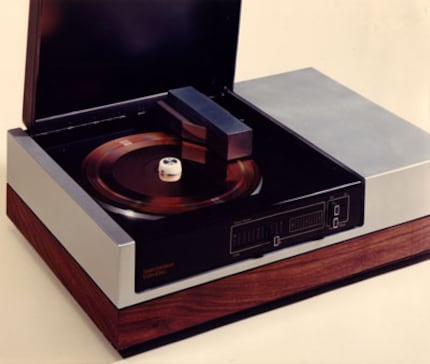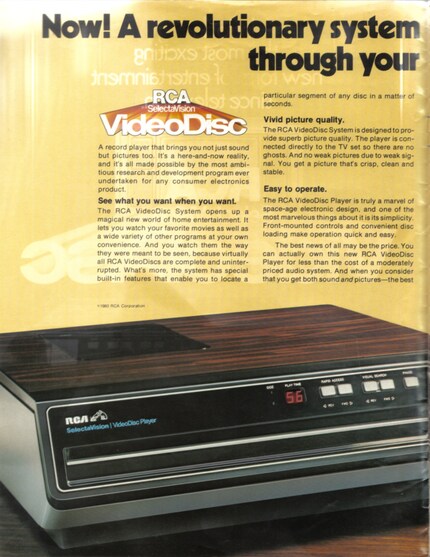
Guide
Who actually needs UHD Blu-rays?
by Luca Fontana

The movie «Back to the Future» was once available on vinyl. No, not the soundtrack. The movie. However, the moment the video record was born, it bombed.
Never heard of CED? No surprise there. After all, it was a gigantic flop. In Europe, it was only on the market for a few months, which is in total disproportion to time its development required: 17 years from the idea to market maturity.
CED stands for Capacitance Electronic Disc. It’s a disc that works similarly to a vinyl record. But instead of sound, it plays back video. A video record, in other words.
For the company that developed it, CED was the end.
This is a story that goes back to the 1960s. A time when vinyl records were very popular and common. This made music affordable, even if you weren’t well heeled. At this point in time, most households in the US were also equipped with a TV. However, movies to watch on your TV at home didn’t exist. It therefore seemed logical to apply the principle of vinyl records to videos.
The US-American electronics company RCA started working on this kind of video record in 1964. But they didn’t go all out and only had four people working on the project at the beginning – in spite of the fact that this was a technically demanding task. To apply the record principle to videos, much more information has to be transferred. It requires a bandwidth at least 150 times higher than for sound only.
To achieve the required density of information, a video record needs to spin much faster than a music record and its grooves must be much smaller. This makes it prone to errors, as records wear out over time. The smaller the groove, the bigger the problem. The pickup jumps out of the groove very easily, and the disc becomes unplayable. To counteract this, RCA covered the records in a thin layer of silicone, which served as a lubricant.
In 1973, almost nine years after the launching its project, RCA was ready with a first prototype. The disc managed to save 10 minutes of video material. It was way too little. After all, the goal was to press full-length feature films onto one vinyl record.

By this time, there must’ve been far more than four people working on the project. It’s assumed that the entire development of the CED cost RCA 600 million dollars.
Back in Europe, a similar project had already been completed in 1970. The «Television Disc», or TED for short, hit the market. But it faced similar problems as the first prototype by RCA: short playback times, sensitive records. The TED disappears after a very brief stint.
Meanwhile, RCA continues to work on its project. The grooves need to become even smaller. The company starts working on a record that, unlike a standard record, isn’t made up of 100 per cent polyvinyl chloride (PVC), but is reinforced with carbon fibres. These fibres are conductive – a necessary property, as reading a CED works differently than a record. And finally, the discs need to be sealed in a plastic box, as even the smallest specks of dust would render them unplayable. The record is inserted into the player in its box. The player then takes the disc out to play it and slides it back into the box before ejecting the record. In other words, the consumer never comes into contact with the actual record.
But even with this protective mechanism, the CED is still very prone to issues caused by dirt and wear.
Video records are much more complex than music records. But there’s one thing the CED has in common with a music record right to the very end. It needs to be flipped to side B halfway through. The only difference being that this is a really tricky affair with the CED because of its plastic box.
In spite of the obvious troubles, RCA didn’t give up. And it payed off. The CED reached market maturity. However, only in 1981, which was way too late
considering the VHS had already been on the market in Japan since 1976. The launch of the CED had been planned for 1977. It was delayed because the disc could only save 30 minutes of video material and wasn’t yet sturdy enough. When the first CED player finally hit North American stores in 1981, the video cassette was already fully established in RCA’s home market, the USA.
During the CED’s long development period, RCA went through troublesome times including several changes in management. In the 1970s, the company struggled with increasingly strong Japanese competition, withdrew from the mainframe computer business and came up with a few more flops. The unsuccessful gaming console Studio II, for example. The costly failure with the CEDs was the nail in the coffin for an already struggling group.
The company was dissolved in 1986.
Did RCA not foresee the rise of the video cassette? Yes, it did. RCA was even manufacturing VHS players and cassettes in Japan and selling them on a large scale.
So why on Earth did RCA cling to the CED idea to the point of self-destruction?
The idea behind the laborious birth of the CED was as follows: although developing a video record is expensive, it would pay off once it was done. This is because PVC sheets can be pressed and therefore produced cheaply in huge quantities. Magnetic tapes, on the other hand, must be recorded individually. This makes the mass production of records much easier and cheaper. A record player can also be produced relatively inexpensively; the mechanics are less complex than those of magnetic tape technology.

And that’s true. RCA offered both the players and the records at a lower price than it would be able to with VHS. But that wasn’t decisive. People used videotapes differently.
On the one hand, they used them to record TV shows, using the same tape several times if required. But most importantly, people typically didn’t buy movies. They rented them from video stores. Obviously. You only watch most movies once anyway. And video stores were shooting up like mushrooms in the early 1980s. The fact that cassettes could be used multiple times meant that fewer needed to be produced. This also made them more expensive.
After this spectacular flop, one thing became clear: the idea of a video record was downright crazy. Nobody would ever try something like that again. But only two years later, in 1983, a Japanese company launched a VHD disc. It was a video record made of carbon reinforced vinyl that had to be enclosed in a plastic box because it was so delicate.
That in and of itself is weird enough. What’s even weirder is that said Japanese company was none other than JVC – the group that successfully established the VHS cassette. In other words, the very technology that killed the video record.
VHD also bombs. Albeit not as spectacularly as the CED. Technologically speaking, the VHD is far better and offers features like 3D movies and interactive movies. They’re the kind that allow you to make decisions that influence the story. This is possible because the VHD can skip to a different place.
In the 1970s, the Japanese industry was very successful at copying existing technologies and improving them. In this case, however, they were perfecting a technology that was doomed.
1986 saw the launch of the LaserDisc. Although its massive price tag prevented it from being a big hit, it was the technology of the future. As the name suggests, the information on the disc is read by means of a laser beam. Unlike the record player, this has the advantage that there’s no mechanical wear and tear. The LaserDisc works in the same way as the CD, DVD and Blu-ray does later on.
This takes us back to the future, where optical storage media has also become obsolete.
Here’s a video recommendation, which also served as a source for this article. On his Youtube channel Technology Connections, Alec talks about the story of the CED and the RCA corporation. He goes into more detail than would have fit on one side of a CED.
My interest in IT and writing landed me in tech journalism early on (2000). I want to know how we can use technology without being used. Outside of the office, I’m a keen musician who makes up for lacking talent with excessive enthusiasm.